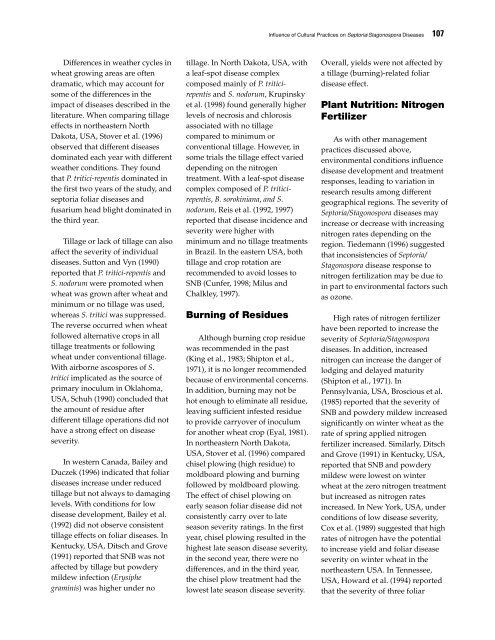Septoria and Stagonospora Diseases of Cereals - CIMMYT ...
Septoria and Stagonospora Diseases of Cereals - CIMMYT ...
Septoria and Stagonospora Diseases of Cereals - CIMMYT ...
Create successful ePaper yourself
Turn your PDF publications into a flip-book with our unique Google optimized e-Paper software.
Differences in weather cycles in<br />
wheat growing areas are <strong>of</strong>ten<br />
dramatic, which may account for<br />
some <strong>of</strong> the differences in the<br />
impact <strong>of</strong> diseases described in the<br />
literature. When comparing tillage<br />
effects in northeastern North<br />
Dakota, USA, Stover et al. (1996)<br />
observed that different diseases<br />
dominated each year with different<br />
weather conditions. They found<br />
that P. tritici-repentis dominated in<br />
the first two years <strong>of</strong> the study, <strong>and</strong><br />
septoria foliar diseases <strong>and</strong><br />
fusarium head blight dominated in<br />
the third year.<br />
Tillage or lack <strong>of</strong> tillage can also<br />
affect the severity <strong>of</strong> individual<br />
diseases. Sutton <strong>and</strong> Vyn (1990)<br />
reported that P. tritici-repentis <strong>and</strong><br />
S. nodorum were promoted when<br />
wheat was grown after wheat <strong>and</strong><br />
minimum or no tillage was used,<br />
whereas S. tritici was suppressed.<br />
The reverse occurred when wheat<br />
followed alternative crops in all<br />
tillage treatments or following<br />
wheat under conventional tillage.<br />
With airborne ascospores <strong>of</strong> S.<br />
tritici implicated as the source <strong>of</strong><br />
primary inoculum in Oklahoma,<br />
USA, Schuh (1990) concluded that<br />
the amount <strong>of</strong> residue after<br />
different tillage operations did not<br />
have a strong effect on disease<br />
severity.<br />
In western Canada, Bailey <strong>and</strong><br />
Duczek (1996) indicated that foliar<br />
diseases increase under reduced<br />
tillage but not always to damaging<br />
levels. With conditions for low<br />
disease development, Bailey et al.<br />
(1992) did not observe consistent<br />
tillage effects on foliar diseases. In<br />
Kentucky, USA, Ditsch <strong>and</strong> Grove<br />
(1991) reported that SNB was not<br />
affected by tillage but powdery<br />
mildew infection (Erysiphe<br />
graminis) was higher under no<br />
tillage. In North Dakota, USA, with<br />
a leaf-spot disease complex<br />
composed mainly <strong>of</strong> P. triticirepentis<br />
<strong>and</strong> S. nodorum, Krupinsky<br />
et al. (1998) found generally higher<br />
levels <strong>of</strong> necrosis <strong>and</strong> chlorosis<br />
associated with no tillage<br />
compared to minimum or<br />
conventional tillage. However, in<br />
some trials the tillage effect varied<br />
depending on the nitrogen<br />
treatment. With a leaf-spot disease<br />
complex composed <strong>of</strong> P. triticirepentis,<br />
B. sorokiniana, <strong>and</strong> S.<br />
nodorum, Reis et al. (1992, 1997)<br />
reported that disease incidence <strong>and</strong><br />
severity were higher with<br />
minimum <strong>and</strong> no tillage treatments<br />
in Brazil. In the eastern USA, both<br />
tillage <strong>and</strong> crop rotation are<br />
recommended to avoid losses to<br />
SNB (Cunfer, 1998; Milus <strong>and</strong><br />
Chalkley, 1997).<br />
Burning <strong>of</strong> Residues<br />
Although burning crop residue<br />
was recommended in the past<br />
(King et al., 1983; Shipton et al.,<br />
1971), it is no longer recommended<br />
because <strong>of</strong> environmental concerns.<br />
In addition, burning may not be<br />
hot enough to eliminate all residue,<br />
leaving sufficient infested residue<br />
to provide carryover <strong>of</strong> inoculum<br />
for another wheat crop (Eyal, 1981).<br />
In northeastern North Dakota,<br />
USA, Stover et al. (1996) compared<br />
chisel plowing (high residue) to<br />
moldboard plowing <strong>and</strong> burning<br />
followed by moldboard plowing.<br />
The effect <strong>of</strong> chisel plowing on<br />
early season foliar disease did not<br />
consistently carry over to late<br />
season severity ratings. In the first<br />
year, chisel plowing resulted in the<br />
highest late season disease severity,<br />
in the second year, there were no<br />
differences, <strong>and</strong> in the third year,<br />
the chisel plow treatment had the<br />
lowest late season disease severity.<br />
Influence <strong>of</strong> Cultural Practices on <strong>Septoria</strong>/<strong>Stagonospora</strong> <strong>Diseases</strong> 107<br />
Overall, yields were not affected by<br />
a tillage (burning)-related foliar<br />
disease effect.<br />
Plant Nutrition: Nitrogen<br />
Fertilizer<br />
As with other management<br />
practices discussed above,<br />
environmental conditions influence<br />
disease development <strong>and</strong> treatment<br />
responses, leading to variation in<br />
research results among different<br />
geographical regions. The severity <strong>of</strong><br />
<strong>Septoria</strong>/<strong>Stagonospora</strong> diseases may<br />
increase or decrease with increasing<br />
nitrogen rates depending on the<br />
region. Tiedemann (1996) suggested<br />
that inconsistencies <strong>of</strong> <strong>Septoria</strong>/<br />
<strong>Stagonospora</strong> disease response to<br />
nitrogen fertilization may be due to<br />
in part to environmental factors such<br />
as ozone.<br />
High rates <strong>of</strong> nitrogen fertilizer<br />
have been reported to increase the<br />
severity <strong>of</strong> <strong>Septoria</strong>/<strong>Stagonospora</strong><br />
diseases. In addition, increased<br />
nitrogen can increase the danger <strong>of</strong><br />
lodging <strong>and</strong> delayed maturity<br />
(Shipton et al., 1971). In<br />
Pennsylvania, USA, Broscious et al.<br />
(1985) reported that the severity <strong>of</strong><br />
SNB <strong>and</strong> powdery mildew increased<br />
significantly on winter wheat as the<br />
rate <strong>of</strong> spring applied nitrogen<br />
fertilizer increased. Similarly, Ditsch<br />
<strong>and</strong> Grove (1991) in Kentucky, USA,<br />
reported that SNB <strong>and</strong> powdery<br />
mildew were lowest on winter<br />
wheat at the zero nitrogen treatment<br />
but increased as nitrogen rates<br />
increased. In New York, USA, under<br />
conditions <strong>of</strong> low disease severity,<br />
Cox et al. (1989) suggested that high<br />
rates <strong>of</strong> nitrogen have the potential<br />
to increase yield <strong>and</strong> foliar disease<br />
severity on winter wheat in the<br />
northeastern USA. In Tennessee,<br />
USA, Howard et al. (1994) reported<br />
that the severity <strong>of</strong> three foliar









